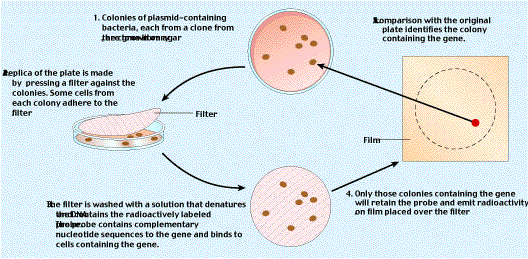4II: Finding the Gene of Interest.A clone library may contain anywhere from a few dozen to many thousand individual fragments of source DNA. Many of those fragments will be identical, so to assemble a complete library of the entire source genome, several hundred thousand clones could be required. A complete Drosophila (fruit fly) library, for example, contains more than 40,000 different clones; a complete human library consisting of fragments 20 kilobases long would require close to a million clones. To search such an immense library for a clone that contains a fragment corresponding to a particular gene requires ingenuity, but many different approaches have been successful.
The most general procedure for screening clone libraries to find a particular gene is hybridization (figure 7). In this method, the cloned genes form base-pairs with complementary sequences on another nucleic acid. The complementary nucleic acid is called a probe because it is used to probe for the presence of the gene of interest. At least part of the nucleotide sequence of the gene of interest must be known to be able to construct the probe.
In this method of screening, bacterial colonies containing an inserted gene are grown on agar. Some cells are transferred to a filter pressed onto the colonies, forming a replica of the plate. The filter is then treated with a solution that denatures the bacterial DNA and that contains a radioactively labeled probe. The probe hybridizes with complementary single-stranded sequences on the bacterial DNA.
When the filter is laid over photographic film, areas that contain radioactivity will expose the film (autoradiography). Only colonies which contain the gene of interest hybridize with the radioactive probe and emit radioactivity onto the film. The pattern on the film is then compared to the original master plate, and the gene-containing colonies may be identified.
Genetic engineering generally involves four stages: cleaving the source DNA; making recombinants; cloning copies of the recombinants; and screening the cloned copies for the desired gene. Screening can be achieved by making the desired clones resistant to certain antibiotics and giving them other properties that make them readily identifiable.  Figure 7
Figure 7
Stage 4-II: Using hybridization to identify the gene of interest. (1) Each of the colonies on these bacterial culture plates represents millions of clones descended from a single cell. To test whether a certain gene is present in any particular clone, it is necessary to identify colonies whose cells contain DNA that hybridizes with a probe containing DNA sequences complementary to the gene. (2) Pressing a filter against the master plate causes some cells from each colony to adhere to the filter. (3) The filter is then washed with a solution that denatures the DNA and contains the radioactively labeled probe. (4) Only those colonies that contain DNA that hybridizes with the probe, and thus contain the gene of interest, will expose film in autoradiography. (5) The film is then compared to the master plate to identify the gene-containing colony.